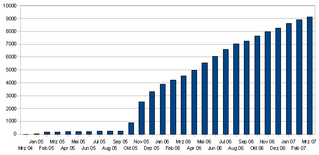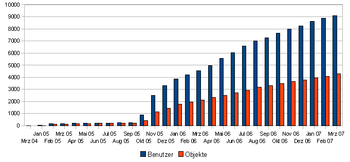PixelPlaza
|
|
|
|---|---|
| "Create and be a part of it!" | |
| Online community and gallery for PixelArt with browser game elements | |
| languages | German English |
| operator | Sebastian Möbius |
| editorial staff | Sebastian Möbius, Michael Graf |
| Registration | required for active participation |
| On-line | March 11, 2006 |
| http://www.pixelplaza.de/ | |
PixelPlaza is a German non-commercial online platform for the collaborative creation of pixel art compositions, based on the principle of Web 2.0 proclaimed by Tim O'Reilly . The platform offers its users the opportunity to submit and exhibit their own individual works of pixel art, where they can be commented on and rated by other users. The design focus is (but not exclusively) on buildings for a virtual city that is created by the community and grows organically. In this way, collective compositions emerge from individual works, in which elements of individual artists are often taken up and continued by other members. The project is an unusual hybrid of browser game elements and an artistic online community such as deviantART, and this mixture is so far unique. The platform was also one of the first comparable websites in German. Today it is the best-known project of its kind in German-speaking countries.
Structure and organization
Virtual floor plan
Similar to the American townships , PixelPlaza consists of so-called grids. These comprise 24 × 24 surface units that can be combined by users to form so-called properties in order to “build” their pixel-art buildings or other works of art on them. Many of these grids are themed and the community members are required to implement these topic specifications such as Venice or Hollywood . Individual grids are grouped in so-called worlds. There are currently three of these worlds:
- In PixelPlaza City , a virtual city is being created according to the original core idea. This idea is sometimes interpreted a little more freely, as the individual districts also extend over different climate zones. Snow-covered roofs and desert slopes on different grids are part of the same virtual city.
- PixelPlaza Fantasy offers creative freedom for those community members who do not want to be restricted by the requirement of having to represent buildings. Here characters from comics, animations, landscapes and many other things are created that do not fit into the core city.
- PixelPlaza Supreme is the smallest world reserved for members who have distinguished themselves through their particularly successful work and the fair and detailed evaluation of other community members. In the beginning, this principle is understood less as a reward, but rather serves the practical purpose of not allowing the otherwise universally accepted beginners' works, which may disturb the overall picture that is supposed to arise from the composition of the individual works, on these few grids
Principles
The platform therefore also offers less professional and experienced designers the opportunity to exhibit their works permanently if they meet certain minimum requirements. The entry and promotion of beginners is supported by a large number of tutorials that have been developed by the providers and, for the most part, by the community. There the handling of common raster graphics programs and design techniques are explained in detail, and creative impulses are given.
What is unusual among comparable artist communities is the fact that the virtual exhibition space is used jointly and, initially, no user account-related separation of the works is recognizable. In the organically growing city, the works of all the authors involved are mixed up in this way, which often leads to inspiration: Often cooperative projects are designed or the ideas of other authors are taken up, supplemented or parodied. In addition, however, there is also the option of calling up all of the works of an individual author in chronological order, although they are shown detached from the design context of the grids.
Playful elements
The platform incorporates elements of a browser game in particular through a virtual currency. The virtual possession of money is necessary in order to acquire exhibition space, the so-called land. However, the currency does not serve as an end in itself, but is designed by the authors as an incentive to improve quality:
For example, detailed commenting on or evaluating the works of other community members is remunerated with a small fixed amount of money, as well as the option to search for hidden treasures in the city, which are only accessible after a certain number of new comments and represent a further profit. Likewise, a rated exhibitor receives a small amount of money, which offers an incentive for the high quality of their own exhibited works.
In addition to the opportunity to earn income through detailed comments, own works also offer the option of regular additional income, so-called commercial installations lead to regular additional income after an initial investment, provided the user is regularly active in the community.
In addition, there are certain random game elements that can lead to money wins, such as lottery winnings.
history
The platform was created as a work by Sebastian Möbius and Michael Graf during their studies at the University of Tübingen , supported by Jirko Cernik, the developer of the browser game Freewar , who also studied there. The public beta phase began on January 30, 2005. After a fourteen-month trial, the project was published on March 11, 2006.
When they finished their studies, the two developers stopped working on the project for the most part, but this was absorbed by the community that was already established at that time.
Efforts are currently being made to involve the community more closely in the development. The server architecture is adapted accordingly.
Statistical data
Users and exhibits
Since the platform was founded, more than 20,000 participants have registered, of which more than 10,000 user accounts currently remain active. To date (August 2008) they have designed and compiled more than 5600 individual pixel art objects.
| (As of March 2007) | |
activity
Around 1000 users are regularly active in the community and in the first half of 2008 almost 500 new pixel art objects were created, around 1500 existing ones were changed and updated.
By March 2007 (around one year after publication; time of the last complete statistical analysis), around 9,000 users at the time had written a total of almost 120,000 comments and ratings. On average, each user commented on someone else's work about 13 times and each exhibited object received an average of 28 comments. On average, a total of nearly 4,500 comments and ratings were written for exhibited works per month.
Problem areas
Heterogeneous quality and motivation
Since PixelPlaza has a relatively high tolerance limit in terms of skill or style, it is possible for every member to exhibit exercise objects and give their work a personal touch. Thus, the viewer of the virtual city is often presented with a very heterogeneous picture, since many works have completely different design priorities and differ greatly in level, which does not always promote the aesthetic impression.
Also the fact that PixelPlaza addresses two completely incongruent target groups through the intended union of the artist community and browser game does not necessarily lead to a higher dynamic of the project, because here different interests, namely to play, i.e. to achieve quick successes, or to achieve an aesthetic overall composition, sometimes diametrically opposed.
One solution was tried with “Pixel Plaza Supreme”: an area in which only high quality works with stricter evaluation guidelines should be created; while in the other areas of Pixel Plaza the playful basic idea and the exercise aspect should remain in the foreground. However, “Supreme” could not achieve its goals because only a few users were interested, and has therefore entered a lengthy revision phase.
Copyright Infringement
Beginners and younger community members in particular do not have the necessary awareness of the problem when it comes to image rights. Copyright violations occur again and again when the works of other community members are copied or pixel art from commercial computer games or other websites is presented as one's own work. The particular difficulty here is to prove the copyright infringement, since the sources are often not traceable. In practice, a well-founded suspicion is sufficient for a corresponding work to be removed by the moderators of the community. Clues are strikingly different styles in several works by a user, an unsuitable scale or poor fit into the specified image format, as well as crude modifications that are clearly recognizable as such.
financing
The problem of financing the running costs for operating the platform has not yet been conclusively clarified. It was originally planned that the project should be self-financed through advertising. However, the few fixed advertising spaces have either not been used or not profitable enough. In addition, animated, flying objects above the “city” are supposed to pull advertising banners from sponsors through the picture, which has not been able to generate sufficient financial volume so far.
To this day, the project has mainly been funded by the founders' private funds and the long-term maintenance of the services is not guaranteed. According to the operator, a solution is being worked on.
internationalization
Although the interface of the platform is completely translated into English and many of the basic tutorials set up by the provider are also available in two languages, the large quantities of advanced tutorials and articles that have been developed by the community over time are almost exclusively based on German available. A transfer of this content into English has not been considered due to the enormous amount and the effort involved, which is a slight disadvantage for the international members of the community. This disadvantage is somewhat compensated for by the fact that large parts of the tutorials are based on illustrations that remain understandable even without the textual explanations.
Reviews and media coverage
Browser game charts
PixelPlaza is currently (as of October 2008) among the top 100 German browser games. In the same ranking, which is updated every day, the platform temporarily achieved a top 50 position. This is remarkable because the playful elements of the platform are more in the background, and PixelPlaza is not primarily a browser game.
Competitive offers
In addition to smaller, private websites that show so-called pixel cities and are usually limited in scope to a few dozen buildings on a few screen pages, there are some established and directly comparable websites:
Pixeldam.net
A Dutch, English-speaking community that follows a similar principle is Pixeldam . Here, too, a city is created from isometric pixel art individual works. However, the platform is more commercialized, among other things, there is strong advertising for its own merchandising products. In addition, a paid job exchange is provided for companies that want to recruit pixel art designers from the community.
In addition, Pixeldam is editorially managed, which means that all submitted works are first checked for their quality. This effectively prevents the problem of heterogeneous optics, as occurs in Pixelplaza, but beginner's works will not be accepted if they do not meet the high standards of the community. Playful elements like those in PixelPlaza do not exist in Pixeldam.
Community and derivative projects
A slowdown in the development of the platform software, caused by the withdrawal of the initiators from active community work, meant that large parts of the development work were taken over by the community and complementary projects were also launched: for example, there was one Independent website that is used to organize design competitions. In addition, applications were made available to members that allow them to create pixel graphics online or provide community services such as a “buddy list”.
See also
Individual evidence
- ↑ Google search for "Pixel-Art Community" in German pages , or internationally
- ↑ Browser game charts at galaxy-news.de
- ↑ Whois pixeldam.net
- ↑ PixelPlaza competitions ( Memento from February 8, 2008 in the Internet Archive )

